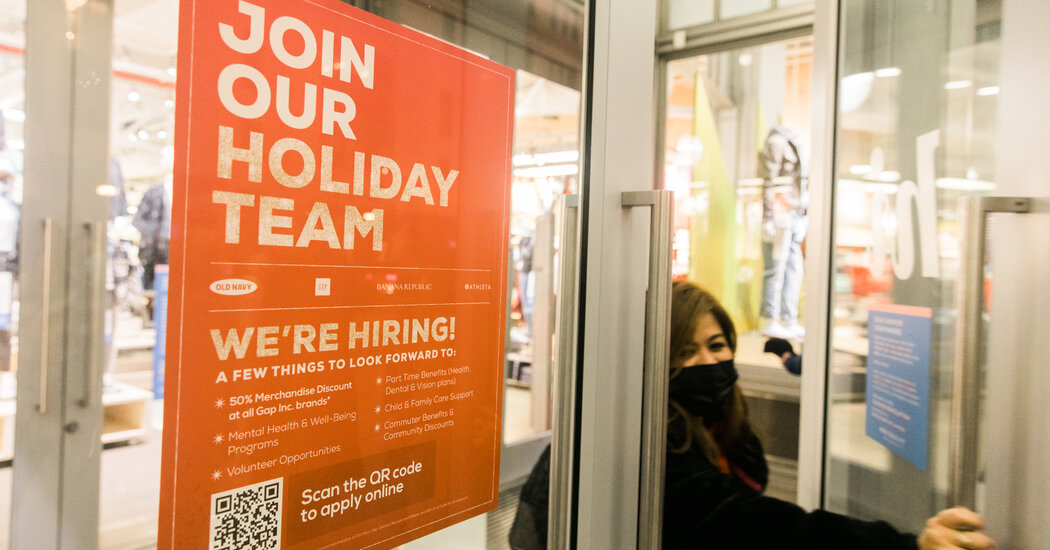Employers are still struggling to fill millions of open jobs — and to hold on to the workers they already have.
More than 4.4 million workers quit their jobs voluntarily in September, the Labor Department said Friday. That was up from 4.3 million in August and was the most in the two decades the government has been keeping track. Nearly a million quit their jobs in the leisure and hospitality industry alone, reflecting the steep competition for workers there as businesses recover from last year’s pandemic-induced shutdowns.
There were 10.4 million job openings in the United States at the end of September. That is down a bit from the record 11.1 million posted in July, before the spread of the Delta variant of the coronavirus led to a slump in sales in some businesses. But demand for labor remains extraordinarily high by historical standards — before the pandemic, the record for job openings in a month was 7.6 million in November 2018. The Labor Department revised its estimate of job openings in August to 10.6 million.
There were roughly 75 unemployed workers for every 100 job openings in September, the lowest ratio on record. Separate data released last week by the Labor Department showed that job growth rebounded in October but that the labor force barely grew.
“You’re essentially seeing demand continuing to increase without an offsetting increase in talent,” said Ryan Sutton, a district director for Robert Half International, a staffing firm. “Until some new talent comes in, until we get employees who are on the sidelines back into the market, it’s very likely this is going to continue.”
Economists cite a number of reasons for the slow return. The pandemic is still disrupting child care, making it hard for some parents to work; other workers are worried about contracting the virus or spreading it to high-risk family members. Many Americans have also built up their savings during the pandemic, allowing them to be choosier about jobs.
The Status of U.S. Jobs
The pandemic continues to impact the U.S. economy in a multitude of ways. One key factor to keep an eye on is the job market and how it changes as the economic recovery moves forward.
Those factors are likely to ease as the pandemic ebbs and savings dwindle. But other shifts could prove more lasting. In a research note published Friday, economists at Goldman Sachs observed that roughly two-thirds of the people who had left the labor force during the pandemic were over 55; many of them have retired and are unlikely to go back to work.
The labor crunch is giving workers the upper hand in negotiations. Wages have risen sharply in recent months, particularly in service jobs, although in other industries pay is lagging behind the pace of inflation.
The recent rise in the number of workers quitting suggests that many are taking advantage of their leverage to accept better-paying jobs, or to look for them. At the same time, understaffing in many businesses may be putting stress on remaining workers, leading even more people to leave their jobs. Industries that require most employees to work in person, such as manufacturing, retail and health care — as well as leisure and hospitality — report the biggest increases in the rate of workers leaving their jobs.
“We are seeing big pickups in quits in the industries that are having the hardest time hiring right now,” said Nick Bunker, director of economic research for the job site Indeed.
Kaylie Sweeting worked as a bartender in Millburn, N.J., through most of the pandemic, despite concerns about interacting with unmasked customers and frustration about low wages. But when the restaurant pressured a colleague to come to work sick this summer, Ms. Sweeting quit.
“The job was absolutely no longer worth it,” she said. “I was hurt that a company that I gave my time to did not seem to prioritize me or my safety.”
So Ms. Sweeting, 23, and her partner, a cook, decided to take the money they had saved to buy a house and open their own vegan restaurant instead. They recently signed a lease and are beginning renovations, with plans to open early next year. They are trying to apply the lessons they have learned as employees, promising good wages, paid time off and other basic benefits that restaurant jobs have often failed to provide.
“I genuinely love the industry,” Ms. Sweeting said. “I just don’t love the way it’s managed. I feel like the only way to change it is to implement the change yourself.”
